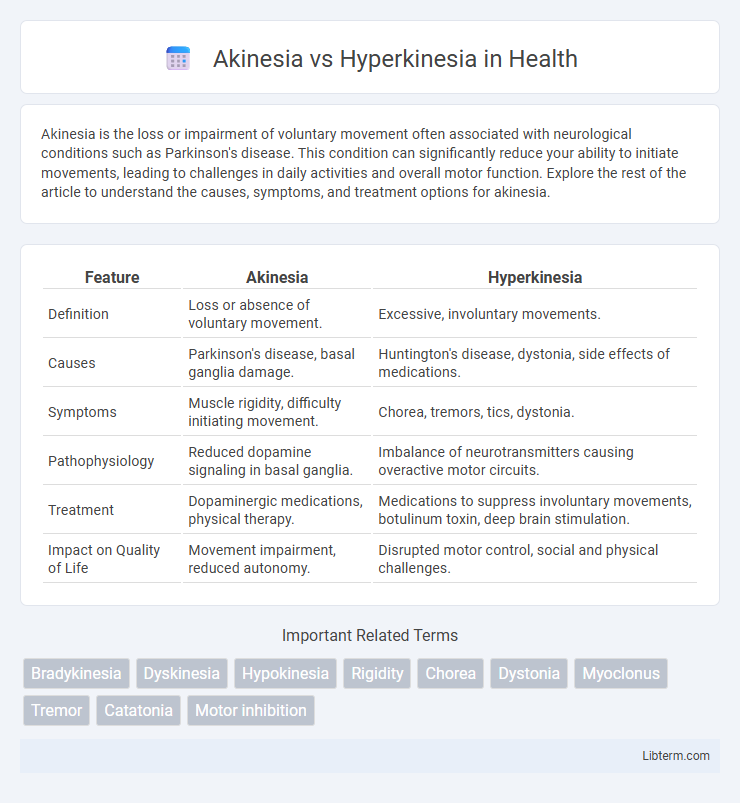Akinesia is the loss or impairment of voluntary movement often associated with neurological conditions such as Parkinson's disease. This condition can significantly reduce your ability to initiate movements, leading to challenges in daily activities and overall motor function. Explore the rest of the article to understand the causes, symptoms, and treatment options for akinesia.
Table of Comparison
| Feature | Akinesia | Hyperkinesia |
|---|---|---|
| Definition | Loss or absence of voluntary movement. | Excessive, involuntary movements. |
| Causes | Parkinson's disease, basal ganglia damage. | Huntington's disease, dystonia, side effects of medications. |
| Symptoms | Muscle rigidity, difficulty initiating movement. | Chorea, tremors, tics, dystonia. |
| Pathophysiology | Reduced dopamine signaling in basal ganglia. | Imbalance of neurotransmitters causing overactive motor circuits. |
| Treatment | Dopaminergic medications, physical therapy. | Medications to suppress involuntary movements, botulinum toxin, deep brain stimulation. |
| Impact on Quality of Life | Movement impairment, reduced autonomy. | Disrupted motor control, social and physical challenges. |
Understanding Akinesia and Hyperkinesia
Akinesia refers to the absence or loss of voluntary movement, commonly observed in Parkinson's disease, characterized by difficulty initiating movement and muscular rigidity. Hyperkinesia involves excessive, involuntary movements such as tremors, chorea, or tics, often linked to neurological disorders like Huntington's disease or Tourette syndrome. Understanding the distinct pathophysiological mechanisms and clinical manifestations of akinesia and hyperkinesia is crucial for accurate diagnosis and targeted treatment strategies.
Defining Akinesia: Causes and Symptoms
Akinesia is characterized by the inability to initiate voluntary movements, commonly seen in Parkinson's disease due to dopamine depletion in the substantia nigra. Symptoms include muscle rigidity, freezing episodes, and reduced facial expression, often resulting in severe motor impairment. Causes extend beyond Parkinson's to include drug-induced parkinsonism and neurodegenerative disorders affecting basal ganglia function.
Exploring Hyperkinesia: Key Characteristics
Hyperkinesia is characterized by excessive involuntary movements such as chorea, tremors, and tics, often linked to basal ganglia dysfunction. It contrasts with akinesia, which involves a marked reduction or absence of voluntary movement, commonly seen in Parkinson's disease. Understanding hyperkinesia's neural mechanisms helps in diagnosing disorders like Huntington's disease and dyskinesia.
Major Differences Between Akinesia and Hyperkinesia
Akinesia involves a marked reduction or complete absence of voluntary movement, often seen in conditions like Parkinson's disease, characterized by muscle rigidity and slow initiation of movement. Hyperkinesia, in contrast, features excessive, involuntary movements such as tremors, chorea, or tics, commonly associated with disorders like Huntington's disease or tardive dyskinesia. The major difference lies in akinesia's suppression of movement versus hyperkinesia's abnormal increase in motor activity.
Neurological Mechanisms Involved
Akinesia involves a significant reduction or absence of voluntary movement primarily due to dopamine depletion in the basal ganglia, disrupting the motor circuit between the substantia nigra and striatum. Hyperkinesia results from excessive or abnormal involuntary movements triggered by imbalances in excitatory and inhibitory signals within the basal ganglia-thalamocortical pathways, often linked to GABAergic dysfunction or increased glutamatergic activity. Both conditions reflect distinct pathophysiological alterations in the motor control networks of the central nervous system.
Common Disorders Associated with Akinesia
Akinesia is commonly associated with Parkinson's disease, characterized by a marked reduction in voluntary movement due to basal ganglia dysfunction. Other disorders linked to akinesia include progressive supranuclear palsy and multiple system atrophy, both involving impaired motor control. These conditions exhibit symptoms such as muscle rigidity, bradykinesia, and difficulty initiating movement, distinguishing them from hyperkinetic disorders.
Conditions Linked to Hyperkinesia
Hyperkinesia is commonly associated with neurological disorders such as Huntington's disease, characterized by involuntary, rapid movements affecting coordination and muscle control. Other conditions linked to hyperkinesia include Tourette syndrome, which presents with sudden motor and vocal tics, and drug-induced dyskinesias caused by long-term use of antipsychotic medications. In contrast, akinesia involves diminished movement often seen in Parkinson's disease, highlighting distinctly different motor function impairments.
Diagnostic Approaches and Tools
Diagnostic approaches for akinesia primarily involve clinical assessment of motor function, utilizing tools such as the Unified Parkinson's Disease Rating Scale (UPDRS) to quantify movement initiation difficulties and rigidity. Hyperkinesia diagnosis often incorporates neuroimaging techniques like MRI or PET scans to detect abnormal brain activity alongside electromyography (EMG) to assess involuntary muscle contractions. Both conditions benefit from video-based movement analysis and genetic testing when hereditary movement disorders are suspected, enhancing diagnostic precision.
Treatment and Management Strategies
Treatment for akinesia primarily involves dopaminergic medications such as levodopa and dopamine agonists to enhance motor initiation, alongside physical therapy to improve mobility and prevent complications. Hyperkinesia management focuses on medications like tetrabenazine and antipsychotics to reduce excessive involuntary movements, supported by physical and occupational therapy to maintain function and quality of life. Advanced interventions like deep brain stimulation (DBS) are considered in both conditions when pharmacological treatments prove insufficient.
Prognosis and Quality of Life Considerations
Akinesia, characterized by a marked reduction in voluntary movement, often leads to progressive motor disability and challenges in daily functioning, significantly impacting quality of life over time. Hyperkinesia involves excessive involuntary movements that can cause functional impairment, social stigmatization, and increased risk of injury, affecting patients' physical and psychological well-being. Prognosis varies with underlying causes; akinesia linked to neurodegenerative diseases may result in steady decline, whereas hyperkinesia due to reversible conditions or controlled with medication can have a more favorable outlook.
Akinesia Infographic

 libterm.com
libterm.com